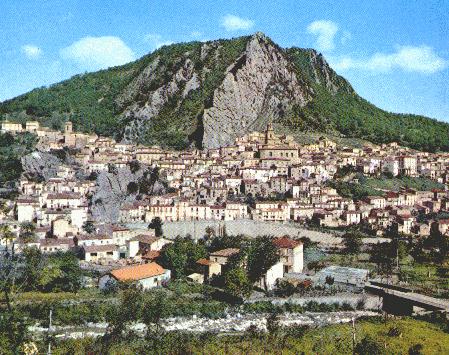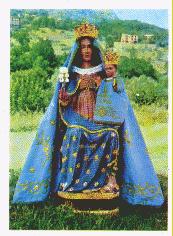

As far as it is known, the origin of our Sabatini family and branches
that developed before the 1940s can be traced to Villa Santa Maria, a small
town in Abruzzo, a mountainous region of central Italy.![]() VERSIONE
ITALIANA
VERSIONE
ITALIANA![]()

Villa S. Maria is located at the feet of a vertical rock called LA PENNA and extends into the shallow floodplain of the SANGRO, a fast flowing river that empties into the Adriatic, 30 miles away.
According to the Kronicon Vulturnense--an ancient cronicle--the town originated in 828 with the construction of the Sanctuary of the Madonna in Basilico (iuxta Sandri fluvium sita...) by the French Benedictine Order. Around the year 1000, Villa S. Maria was first part of the Duchy of Benevento, then of the Duchy of Spoleto, then of the Fief of the Borrello family. In 1268, the town was almost completely destroyed during one of the many incursions of the Saracens. A year later, Charles I of Anjou bestowed the land and the town to Rudolf of Cortiniaco, a French nobleman.
In the 14th C. the town rebelled to its feudal lords and was burned down by the Duke of Vaches. In the 1500s, the rebuilt town came under the Caracciolo princes. In the 17th C. the town's population was decimated by the plague, and to afford better protection against banditry, the townspeople moved from the original site on the left of the river to the present site on the right banks of the Sangro and up the steep slopes of the Penna. The rest is recent history.
Important sites are the 17th century St. Nicholas Parish, dedicated
to the town's patron saint. Located beneath the present-day kindergarten
building is the cave of St. Francis Caracciolo,
the town's most famous son and patron saint of Italian cooks. On the opposite
bank of the Sangro is the aforementioned Sanctuary of the Madonna in Basilico
which hosts  a
14th century statue of the madonna . On the road to Montelapiano, there's
a hydroelectric power station that uses the waters of the Sangro made to
flow in tunnels 18 km long dug deep within the mountains. The pride of
Villa S. Maria is its Culinary and Hotel Management School--with students
that come from all part of Italy and the world to study the culinary art
that made Villa's Chefs famous throughout the world.
a
14th century statue of the madonna . On the road to Montelapiano, there's
a hydroelectric power station that uses the waters of the Sangro made to
flow in tunnels 18 km long dug deep within the mountains. The pride of
Villa S. Maria is its Culinary and Hotel Management School--with students
that come from all part of Italy and the world to study the culinary art
that made Villa's Chefs famous throughout the world.
The best time to visit Villa Santa Maria is during the first two weeks of August when Villesi from all over Italy and the world return to enjoy the festivities and to meet relatives and friends. We hope to see you there this year.
For more information, and to subscribe to the newsletter LA PENNA containing information about Villa Santa Maria and its people write to: Associazione Amici di Villa Santa Maria e della Valle del Sangro, Via Alpi Apuane 1, Rome 00141, Italy. or visit the site Friends of Villa Santa Maria
Images of Saint Francis Caracciolo by the artist Rocco Olivo Castracane
Knights and Armatures- by Stefano Castracane
![]()
Send your comments to Romeo Sabatini. E-mail: sabatini@hotmail.com